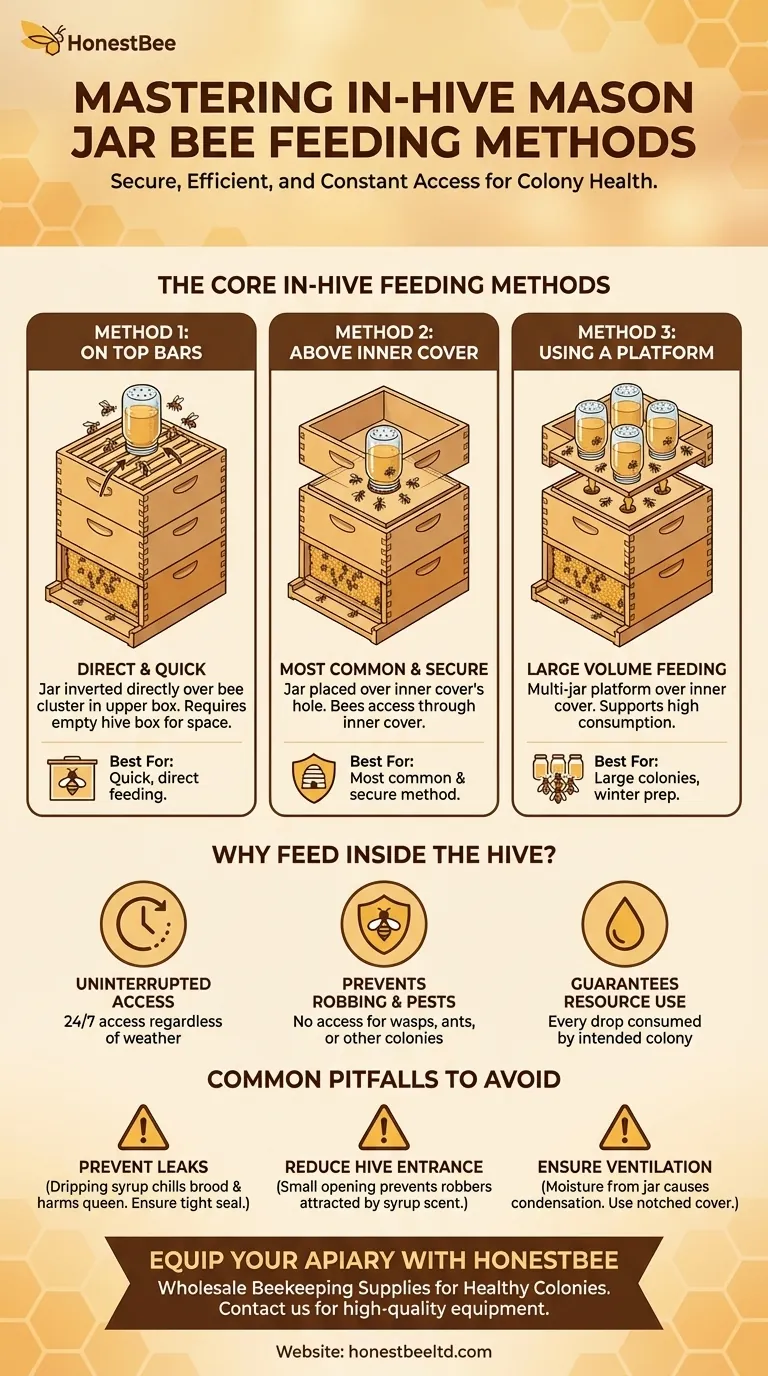The most common methods for in-hive mason jar feeding involve placing the jar directly on the top bars of the frames or, more securely, positioning it over the hole in the hive's inner cover. This internal approach is designed to give your bees constant access to food while protecting the resources from weather and robbing insects.
The core principle of in-hive jar feeding is to provide a safe, direct-to-colony food source that eliminates outside competition and weather exposure. The best method utilizes an inner cover and an empty hive box to create a dedicated, protected feeding chamber above the brood nest.

Why Feed Inside the Hive?
Placing feeders internally is a strategic decision that directly benefits the health and security of your colony. It is far more efficient and safer than open or entrance feeding methods.
Uninterrupted Access
Internal feeders give bees 24/7 access to sugar water, regardless of wind, rain, or cool temperatures. This allows them to consume resources as needed, which is especially critical during periods of nectar dearth or rapid colony buildup.
Prevents Robbing and Pests
An internal feeder ensures the sugar syrup is available only to your bees. It prevents other colonies, wasps, and ants from detecting and stealing the food, which can trigger destructive robbing behavior and overwhelm a weak hive.
Guarantees Resource Use
Every drop of syrup placed inside the hive is consumed by the colony it is intended for. This makes in-hive feeding highly economical and efficient, eliminating any waste.
The Core In-Hive Feeding Methods
While the concept is simple, the execution determines its safety and effectiveness. The two primary methods place the jar in different positions relative to the bee cluster.
Method 1: Directly on the Top Bars
This is the most direct method. The feeder jar is inverted and placed directly on the top bars of the frames in the uppermost hive box, ideally right over the main cluster of bees.
To make space, you simply add an empty, medium, or deep hive box on top of the brood box to enclose the jar. The outer cover then goes on top of this empty box.
Method 2: Above the Inner Cover
This is the most common and recommended method. The jar is placed on top of the inner cover, directly over the central hole. This setup creates a more controlled and secure feeding station.
The bees travel up through the hole in the inner cover to access the feed. An empty hive box is used as a spacer to protect the jar, and the outer cover seals the top.
Method 3: Using a Feeding Platform
This is an enhancement of the inner cover method, designed for feeding larger quantities. A wooden platform with one or more holes is placed over the inner cover's hole.
This allows you to place multiple jars at once, providing a large volume of syrup without having to disturb the hive as frequently. This is ideal for feeding a large colony or preparing for winter.
Common Pitfalls to Avoid
Proper setup is crucial. A poorly managed internal feeder can cause more harm than good by creating moisture problems or stressing the colony.
Prevent Leaks at All Costs
A leaky feeder can be disastrous. Syrup dripping down on the bees can chill the brood, drown workers, and potentially harm or kill the queen.
Always ensure your lid is tightly sealed and that the vacuum inside the jar is holding strong before placing it in the hive. Test it by inverting it outside the hive first.
Reduce the Hive Entrance
When feeding, especially a weaker hive, you must reduce the entrance to a very small opening. The smell of sugar syrup can attract robbers, and a smaller entrance is much easier for the colony's guard bees to defend.
Ensure Proper Ventilation
Placing a large, cool jar of syrup inside the hive can create condensation. Ensure your outer cover has a ventilation notch or prop a small stick under one corner of the lid to allow excess moisture to escape.
Summary Table:
| Method | Description | Best For |
|---|---|---|
| On Top Bars | Jar inverted directly over the bee cluster. | Quick, direct feeding. |
| Above Inner Cover | Jar placed over the inner cover's hole. | Most common & secure method. |
| Using a Platform | Multi-jar platform for large-volume feeding. | Large colonies, winter prep. |
Ensure your apiary has the right equipment for safe, effective feeding. HONESTBEE supplies commercial apiaries and beekeeping equipment distributors with high-quality, wholesale beekeeping supplies. From durable hive boxes to reliable inner covers, our products are designed to support healthy, productive colonies. Let us help you stock up on everything you need for successful in-hive management.
Contact HONESTBEE today to discuss your wholesale supply needs!
Visual Guide

Related Products
- HONESTBEE Professional Hive Top Bee Feeder Feeding Solution
- In-Hive Dual Compartment Frame Bee Feeder for Targeted Colony Nutrition
- Professional Hive Top Bee Feeder for Beekeeping
- HONESTBEE Entrance Bee Feeder Professional Hive Nutrition Solution for Beekeeping
- Classic Boardman Entrance Bee Feeder Hive Front Feeding Solution
People Also Ask
- What are the advantages of hive top feeders? Maximize Feeding Efficiency for Your Apiary
- What should be done with feeders and equipment after feeding bees? Essential Steps for Apiary Health
- How do I keep bees from drowning in my top feeder? Ensure Safe Feeding for Your Hive
- What is the best way to top feed bees? A Safe, High-Volume Feeding Solution for Your Apiary
- Why is a top feeder essential for bees? Ensure Colony Health and Efficiency



















